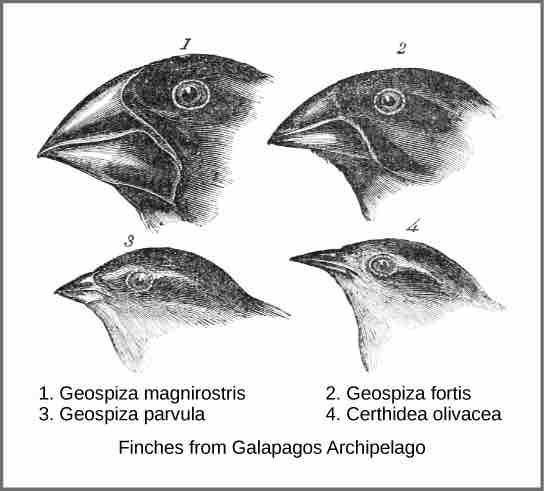Charles Darwin and Natural Selection
In the mid-nineteenth century, the mechanism for evolution was independently conceived of and described by two naturalists: Charles Darwin and Alfred Russel Wallace. Importantly, each naturalist spent time exploring the natural world on expeditions to the tropics. From 1831 to 1836, Darwin traveled around the world to places like South America, Australia, and the southern tip of Africa. Wallace traveled to Brazil to collect insects in the Amazon rainforest from 1848 to 1852 and to the Malay Archipelago from 1854 to 1862. Darwin's journey, as with Wallace's later journeys to the Malay Archipelago, included stops at several island chains, the last being the Galápagos Islands west of Ecuador. On these islands, Darwin observed that species of organisms on different islands were clearly similar, yet had distinct differences. For example, the ground finches inhabiting the Galápagos Islands comprised several species with a unique beak shape . The species on the islands had a graded series of beak sizes and shapes with very small differences between the most similar. He observed that these finches closely resembled another finch species on the mainland of South America. Darwin imagined that the island species might be modified from one of the original mainland species. Upon further study, he realized that the varied beaks of each finch helped the birds acquire a specific type of food. For example, seed-eating finches had stronger, thicker beaks for breaking seeds, while insect-eating finches had spear-like beaks for stabbing their prey.

Beak Shape Among Finch Species
Darwin observed that beak shape varies among finch species. He postulated that the beak of an ancestral species had adapted over time to equip the finches to acquire different food sources.
Natural Selection
Wallace and Darwin observed similar patterns in other organisms and independently developed the same explanation for how and why such changes could take place. Darwin called this mechanism natural selection. Natural selection, also known as "survival of the fittest," is the more prolific reproduction of individuals with favorable traits that survive environmental change because of those traits. This leads to evolutionary change, the trait becoming predominant within a population. For example, Darwin observed that a population of giant tortoises found in the Galapagos Archipelago have longer necks than those that lived on other islands with dry lowlands. These tortoises were "selected" because they could reach more leaves and access more food than those with short necks. In times of drought, when fewer leaves would be available, those that could reach more leaves had a better chance to eat and survive than those that could not reach the food source. Consequently, long-necked tortoises would more probably be reproductively successful and pass the long-necked trait to their offspring. Over time, only long-necked tortoises would be present in the population.
Natural selection, Darwin argued, was an inevitable outcome of three principles that operated in nature. First, most characteristics of organisms are inherited, or passed from parent to offspring, although how traits were inherited was unknown. Second, more offspring are produced than are able to survive. The capacity for reproduction in all organisms outstrips the availability of resources to support their numbers. Thus, there is competition for those resources in each generation. Both Darwin and Wallace were influenced by an essay written by economist Thomas Malthus who discussed this principle in relation to human populations. Third, Darwin and Wallace reasoned that offspring with the inherited characteristics that allow them to best compete for limited resources will survive and have more offspring than those individuals with variations that are less able to compete. Because characteristics are inherited, these traits will be better represented in the next generation. This will lead to change in populations over successive generations in a process that Darwin called descent with modification. Ultimately, natural selection leads to greater adaptation of the population to its local environment; it is the only mechanism known for adaptive evolution.
Papers by Darwin and Wallace presenting the idea of natural selection were read together in 1858 before the Linnean Society in London. The following year, Darwin's book, On the Origin of Species, was published. His book outlined his arguments for evolution by natural selection.

Charles Darwin and Alfred Wallace
Both (a) Charles Darwin and (b) Alfred Wallace wrote scientific papers on natural selection that were presented together before the Linnean Society in 1858.